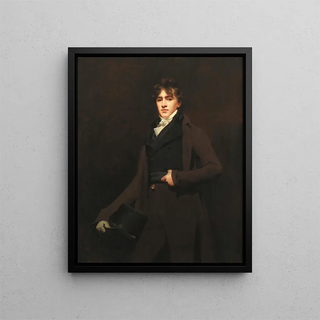Art print | Henry David Erskine, Twelfth Earl of Buchan - Sir Henry Raeburn


View from behind

Frame (optional)
In the fascinating world of 18th-century British painting, the art print "Henry David Erskine, Twelfth Earl of Buchan" by Sir Henry Raeburn stands out for its psychological depth and timeless elegance. This depiction of a Scottish nobleman, imbued with dignity, invites us to explore not only the subject but also the historical and social context of the era. The artist, through his brush, manages to capture the very essence of his model, revealing the subtleties of Erskine's personality while offering a glimpse into the aristocratic values of his time. This work, emblematic of a period when art intertwines with national identity, is a true testament to Scottish history and culture.
Style and uniqueness of the work
Raeburn's style is characterized by refined technique and meticulous attention to detail, which are evident in the portrayal of the Earl of Buchan. The lighting, skillfully orchestrated, highlights the rich textures of the clothing and the delicacy of the facial features. The contrasts of light and shadow, typical of chiaroscuro, give the composition remarkable depth, allowing viewers to feel an almost intimate connection with the subject. The Earl's posture, both solemn and approachable, evokes natural authority, while his gaze, frank and serene, seems to invite reflection. Raeburn thus succeeds in transcending the simple portrait to offer a true character study, where each visual element contributes to the overall narrative.
The artist and his influence
Sir Henry Raeburn, an emblematic figure of Scottish painting, established himself as a master of portraiture through his innovative approach and his ability to capture the soul of his subjects. Trained at the classical art school, he developed a style that blends tradition and modernity, drawing inspiration from the great masters while forging a unique identity. His influence on the Scottish artistic landscape is undeniable, and he paved the way for many artists who followed in his footsteps. Raeburn also played a key role in promoting

Matte finish

View from behind

Frame (optional)
In the fascinating world of 18th-century British painting, the art print "Henry David Erskine, Twelfth Earl of Buchan" by Sir Henry Raeburn stands out for its psychological depth and timeless elegance. This depiction of a Scottish nobleman, imbued with dignity, invites us to explore not only the subject but also the historical and social context of the era. The artist, through his brush, manages to capture the very essence of his model, revealing the subtleties of Erskine's personality while offering a glimpse into the aristocratic values of his time. This work, emblematic of a period when art intertwines with national identity, is a true testament to Scottish history and culture.
Style and uniqueness of the work
Raeburn's style is characterized by refined technique and meticulous attention to detail, which are evident in the portrayal of the Earl of Buchan. The lighting, skillfully orchestrated, highlights the rich textures of the clothing and the delicacy of the facial features. The contrasts of light and shadow, typical of chiaroscuro, give the composition remarkable depth, allowing viewers to feel an almost intimate connection with the subject. The Earl's posture, both solemn and approachable, evokes natural authority, while his gaze, frank and serene, seems to invite reflection. Raeburn thus succeeds in transcending the simple portrait to offer a true character study, where each visual element contributes to the overall narrative.
The artist and his influence
Sir Henry Raeburn, an emblematic figure of Scottish painting, established himself as a master of portraiture through his innovative approach and his ability to capture the soul of his subjects. Trained at the classical art school, he developed a style that blends tradition and modernity, drawing inspiration from the great masters while forging a unique identity. His influence on the Scottish artistic landscape is undeniable, and he paved the way for many artists who followed in his footsteps. Raeburn also played a key role in promoting






